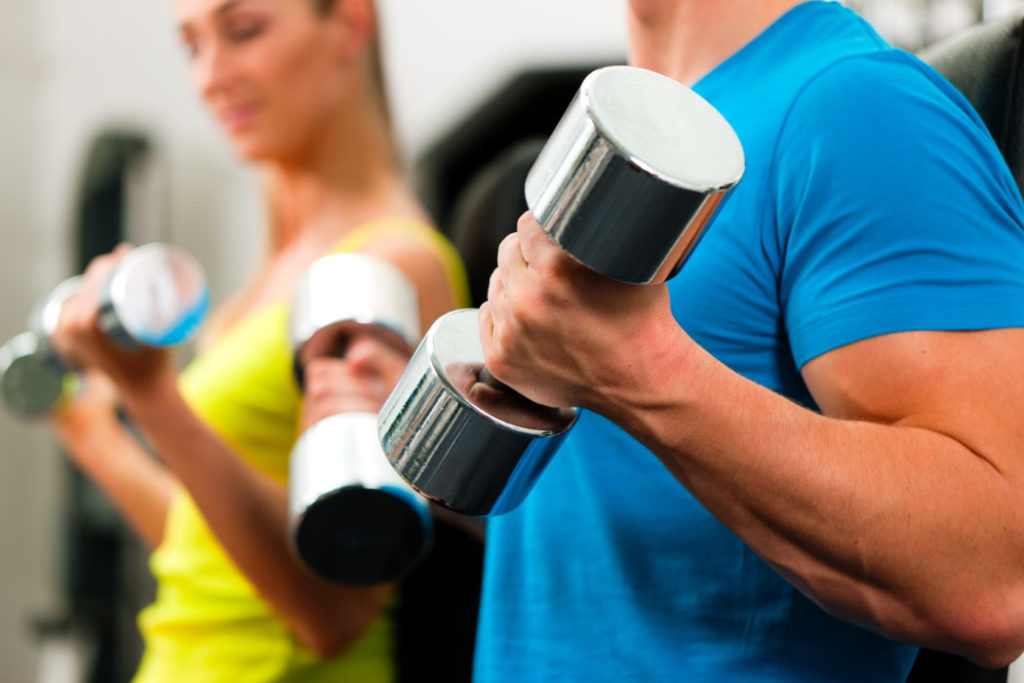Does weight training help you lose fat?
Yes, but not as much as previously thought.
Weight training has long been thought to help you lose fat by increasing your metabolism. It was generally held that fat loss would be stimulated by adding muscle tissue (as muscle is more metabolically active than fat). While that’s true, today’s fitness experts now recognize there is a connection between weight training and fat loss, but it’s not as drastic as we were once led to believe.
So, here’s what you need to understand about weight training and fat loss.
Your body burns 2.05 calories per day for every pound of fat you have. Compare this to the 5.91 calories per day you burn for every one pound of muscle you have. So if you have 20 pounds of muscle, you can burn an extra 120 calories per day for simply having that muscle.
Building muscle still helps your body in plenty of ways
Muscle helps decrease the risk of injuries, improve bone strength, increase general well-being, improve balance, and extend life expectancy, as well as help with insulin sensitivity and nutrient partitioning (both of which allow the food you intake to be used as fuel to help your body recover, as opposed to being stored as fat).
Weight training is also a great calorie burner with cardiovascular impacts
People often think weights can’t help cardio but it’s not like you stop breathing when you are lifting weights! Weight training provides a metabolic boost for the day (or longer depending on the study) by way of the “afterburn” or Excess Post Exercise Oxygen Consumption (EPOC) where your body is burning additional calories after the session. This is something standard cardio doesn’t do!
PRIORITIZE weight training over cardio
You can get cardio simply by daily movement like walking, playing with the kids, going to the store, or even doing household chores. I know this isn’t the sexy sweaty movie montage workout scene you expect but you don’t need to go all out during every workout, save that for the weights!
AVOID excess “boring cardio”
Did you know your body has a threshold of only allowing you to burn a certain amount of calories per day? It’s true. Your body will slow your Non-Exercise Activity Thermogenesis (NEAT) down for the day once you hit the threshold. This means you will subconsciously move less, walk slower, and be more likely to sit on your butt.
So, that hour of hard cardio does not make up for a day of non-activity.
Should you do full bodyweight training or alternative upper and lower body?
Either works. If you are looking for an overall calorie burn, the full-body workout will likely (but not always) help you to burn more calories. However, if you want to do upper/lower body splits, you can do that as well, and it may have more potential to add more muscle tissue. Try to hit about 10 sets per muscle group per week when you weight train close to form failure. Or try to hit 1-2 Reps In Reserve (RIR). RIR is when you can’t lift the weight with good form for another 1 or 2 reps. This can consist of 3-4 sets per body part per workout (i.e., if you are lifting 3 days a week for a full-body routine).
What is the frequency at which you should do cardio to lose weight? How long should you do it?
As you now know, cardio doesn’t have to be a crazy all-out session. My advice is to set a minimum step goal per day, and then from there add 1-3 cardio sessions into your schedule, where you can.
This could be anything from a simple 10-minute walk after every meal to increase digestion and insulin sensitivity to a light jog for 20 minutes after weight training. If you are more of an advanced exerciser, try to do 1-2 HIIT sessions per week, no longer than 25 minutes. Now, this is TRUE HIIT and not some “exertainment” class where your body doesn’t get a rest! This should be a 1:3 work to rest ratio. For example, starting with a warm-up before a 10-second sprint, followed by a 30-second walk for 10 rounds, then a 5-10 minute cool down.
When trying to lose fat, is diet or exercise more important? Or are they equally as important?
SLEEP is most important… then diet, and exercise! If you are overtired, there’s a cascade of events that impact your health goals. You will feel sluggish which leads to a poor workout (or no workout) the next day. A lack of sleep or rest can not only result in making bad dietary choices but can also lead to a higher chance for injury as well.
When looking at your diet, you can’t eat like a bird!
Eat smart. Your body needs proper nutrition to host factors like energy and recovery. Remember, you can’t outwork a bad diet. If you try to outwork that big pizza and ice cream, it’s likely to take several hours of exercise to burn it off!
So get your sleep, focus on your diet, prioritize weights, and simply move more!
Let’s Get Started
Need help getting started on your fitness journey? I’m here for you. My workouts are quick and deliver visible results in just 3 weeks. I created five, 10-minute workouts that target your abs from every angle. Plus five mini-band routines to help you burn fat and sculpt your entire body in under 20 minutes! Learn more about Open Fit, and get on the road to a more healthy life.


